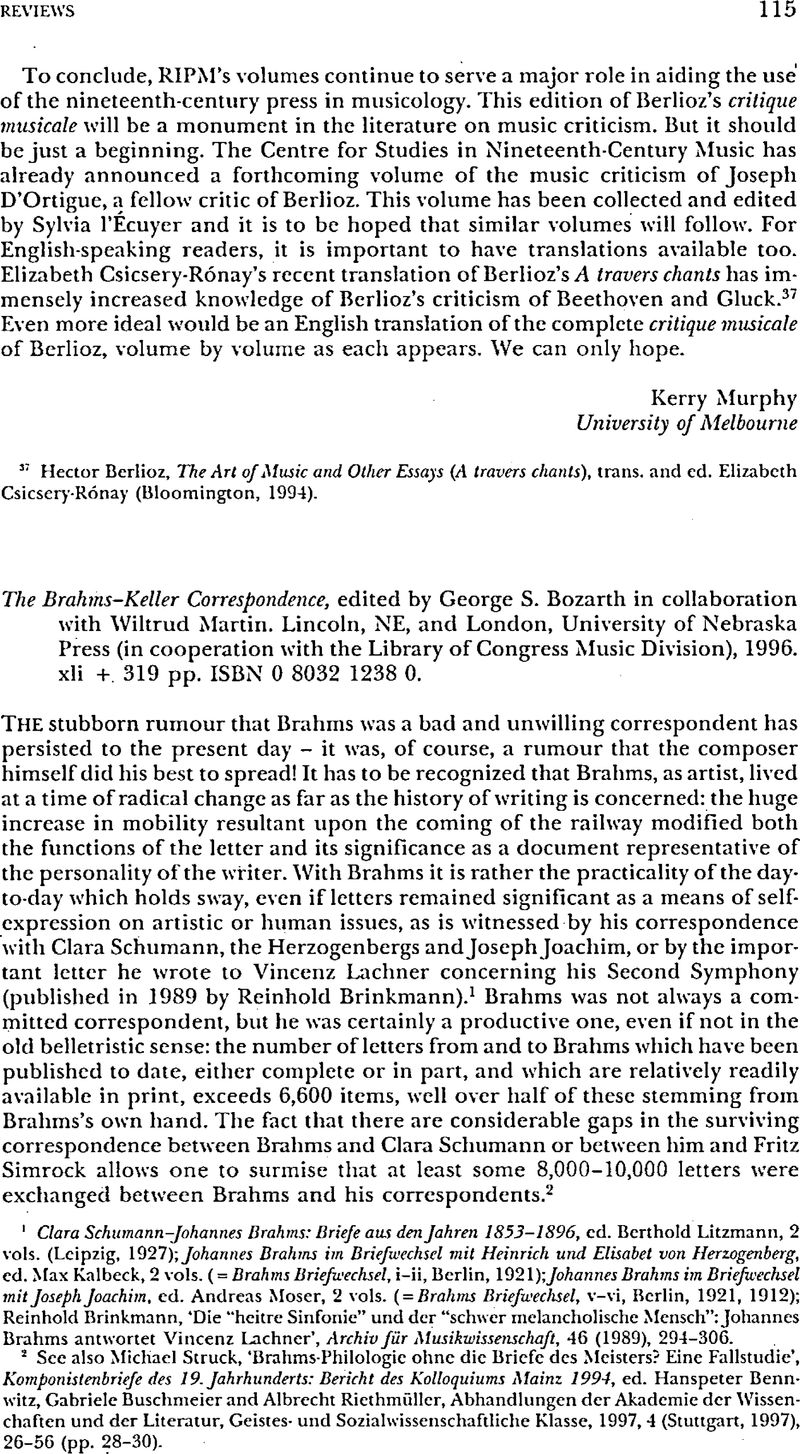No CrossRef data available.
Published online by Cambridge University Press: 01 January 2020

1 Clara Schumann–Johannes Brahms: Briefe aus den Jahren 1853–1896, cd. Berthold Litzmann, 2 vols. (Leipzig, 1927); Johannes Brahms im Briefwechsel mit Heinrich und Elisabet von Herzogenberg, ed. Max Kalbeck, 2 vols. (= Brahms Briefwechsel, i–ii, Berlin, 1921); Johannes Brahms im Briefwechsel mit Joseph Joachim, ed. Andreas Moser, 2 vols. (= Brahms Briefwechsel, v–vi, Berlin, 1921, 1912); Reinhold Brinkmann, ‘Die “heitre Sinfonie” und der “schwer melancholische Mensch”: Johannes Brahms antwortet Vincenz Lachner’, Archiv für Musikwissenschaft, 46 (1989), 294–306.Google Scholar
2 See also Michael Struck, ‘Brahms-Philologie ohne die Briefe des Meisters? Eine Fallstudie’, Komponistenbriefe des 19. Jahrhunderts: Bericht des Kolloquiums Mainz 1994, ed. Hanspeter Bennwitz, Gabriele Buschmeier and Albrecht Riethmüller, Abhandlungen der Akademie der Wissenchaften und der Literatur, Geistes- und Sozialwissenschaftliche Klasse, 1997, 4 (Stuttgart, 1997), 26–56 (pp. 28-30).Google Scholar
3 Johannes Brahms Briefwechsel, 16 vols. (Berlin 1906/7-1922; repr. Tutzing, 1974).Google Scholar
4 Clara Schumann–Johannes Brahms, ed. Litzmann; Billroth und Brahms im Briefwechsel, ed. Otto Gottlieb-Billroth (Berlin and Vienna, 1935); Johannes Brahms und Fritz Simrock - Weg einer Freundschaft: Briefe des Verlegers an den Komponisten, ed. Kurt Stephenson (Hamburg, 1961).Google Scholar
5 Johannes Brahms Briefwechsel: Neue Folge, ed. Otto Biba and Kurt and Renate Hofmann: Johannes Brahms im Briefwechsel mit Herzog Georg II. von Sachsen-Meiningen und Helen Freifrau von Heldburg, ed. Herta Müller and Renate Hofmann (= vol. xvii, Tutzing, 1991); Johannes Brahms im Briefwechsel mit Julius Stockhausen, ed. Renate Hofmann (= vol. xviii, Tutzing, 1993); Johannes Brahms im Briefwechsel mit Ernst Frank, ed. Robert Münster (= vol. xix, Tutzing, 1995). It might also be useful to add: Hans von Bülow: Die Briefe an Johannes Brahms, ed. Hans-Joachim Hinrichsen (Tutzing, 1994); in this edition, with its expert commentary, Brahms's communications to von Bülow are unfortunately cited only as part of the annotations.Google Scholar
6 Johannes Brahms: Briefe an P.J. Simrock und Fritz Simrock, ed. Max Kalbeck, 4 vols. (= Brahms Briefwechsel, ix–xii, Berlin, 1917-19); Johannes Brahms und Fritz Simrock, ed. Stephenson.Google Scholar
7 Reinhold Brinkmann, ‘Brahms-Bücher (Neuerscheinungen)’, Österreichische Musikzeitschrift, 52 (1997), 38–41 (p. 38).Google Scholar
8 The performance in 1865 in Frankfurt by Clara Schumann, cited by Bozarth on p. 137, cannot be regarded as a certainty: it may have been Brahms's Variations on an Original Theme, op. 21 no. 1, that was played on this occasion.Google Scholar
9 Johannes Brahms, Symphonie Nr. 1 c-Moll, opus 68, ed. Robert Pascall, Neue Ausgabe sämtlicher Werke, I/i (Munich, 1996), 231.Google Scholar
10 Ibid., 214.Google Scholar
11 Brahms Briefwechsel, x, 49: ‘Haben Sie doch die Güte und lassen Herrn Keller im Finale nach dem Schluß des Iten Teils (e moll) [i.e. after bar 183! M.S.], wenn die 1te Melodie wieder [!] anfängt, über die erste Geige setzen: largamente. […] Einige Seiten weiter, beim ff [recte: f] Violine I […] muß dann wieder über der ersten Geige stehen: animato’ ('Please be so kind as to have Herr Keller place “largamente” over violin I after the end of the first section (E minor) [that is, after bar 183! M.S.], where the first melody begins again. […] A few pages later, at the ff [recte: f] “animato” should again be put over violin I').Google Scholar
12 Johannes Brahms, Symphonie in e-moll, op. 98: Faksimile des autographen Manuskripts aus dem Besitz, der Allgemeinen Musikgesellschaft Zürich (Adliswil-Zürich, 1974), movement 4, manuscript pp. 7–8.Google Scholar
13 Brahms Briefwechsel, x, 35-6: ‘Ich bemerke, […] daß in den Stimmen Vortragsbezeichnungen u. dergl. bisweilen abweichen sollen, genauer oder ausführlicher sind. Bitte also höchstens ein ? zu machen, nicht zu ändern’ ('I note […] that in the parts the performance markings and suchlike should differ from time to time, where they are more precise or detailed. So please just put a query and don't alter anything').Google Scholar
14 In order to avoid further misunderstanding, it might be useful to note that such proportional relationships are traditionally given in the form: first the new, then the preceding metrical unit.Google Scholar
15 Johannes Brahms: Thematisch-bibliographisches Werkverzeichnis, ed. Margit McCorkle (Munich, 1984), 659; cf. p. 361.Google Scholar
16 Beckerath, Heinz von, ‘Erinnerungen an Johannes Brahms: Brahms und seine Krefelder Freunde’, Heimat, 29 (1958), 81–93 (p. 84).Google Scholar
17 In addition to the editions mentioned in notes 4 and 6 above, it might be useful to note: Johannes Brahms im Briefwechsel mit Breitkopf & Härtel, Bartolf Senff J. Rieter-Biedermann, C. F. Peters, E. W. Fritzsch und Robert Lienau, ed. Wilhelm Altmann (= Brahms Briefwechsel, xiv, Berlin, 1920).Google Scholar